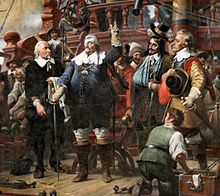Kong Christian stod ved højen mast
| English: King Christian stood by the lofty mast | |
|---|---|
 King Christian IV stood by the lofty mast | |
National and Royal anthem of | |
| Also known as | Kong Christian (short) Kongesangen (English: The King's Anthem) |
| Lyrics | Johannes Ewald, 1778 |
| Music | Composer Unknown |
| Adopted | 1780 |
| Audio sample | |
Kong Christian stod ved højen mast (instrument)
| |
Kong Christian stod ved højen mast (Danish pronunciation: [kʰʌŋ ˈkʰʁestjæn ˈstoˀð ve̝ ˈhʌjˀn̩ mæst]; "King Christian stood by the lofty mast"), commonly shortened to Kong Christian, is the royal anthem of the Kingdom of Denmark. It also has equal status of national anthem together with Der er et yndigt land,[1] though it is almost exclusively used in relation to the Danish royal house and the military. The theme of the song is about the heroics of Danish and Norwegian sailors during the wars against Sweden (including the Torstenson War) in the 17th and 18th centuries.
On New Year's Eve it is tradition to sing along as the Danmarks Radio Girl's Choir sing the song on television, immediately after midnight following the other national anthem. Usually only the first verse is sung on official occasions. Adopted in 1780, it is one of the oldest national anthems in the world.[2]
The lyrics[]
History of the lyrics[]
The lyrics first appeared in May 1778,[3] in Johannes Ewald's vaudeville play, The Fishermen, which premiered at the Royal Danish Theatre in January 1780 on the birthday of King Christian VII. The play depicts the heroics of fishermen from the northern part of Zealand, who saved a lot of sailors from drowning and then refused to take pay for it.[4] For this reason, the play was seen as a tribute to the navy, in particular because of the King Christian song.[citation needed] In the original staging of the play, however, only the final 4th verse was ever sung.[citation needed] The first three verses were omitted because of the animosity they showed towards Sweden, who at the time were an important ally against the United Kingdom as members of the League of Armed Neutrality.[citation needed]
Theme[]
The theme of the song is the heroics of Danish-Norwegian sailors during the wars against Sweden in the 17th and 18th centuries. It specifically names the Danish-Norwegian naval heroes King Christian IV, Niels Juel and Peter Wessel Tordenskiold. The first verse refers to the Battle of Colberger Heide where King Christian IV is hurt by shrapnel and thought to be dead, but quickly gets to his feet and incites his crew to continue the battle.
History of the music[]
It has long been debated who composed the music to the song. It was originally accredited to Johann Hartmann, the same composer who wrote the score for the original play "Fiskerne", where the lyrics had first appeared.[5] Another suggestion was that a friend of Johannes Ewald, High Court judge Ditlev Ludvig Rogert, who was known to have played the violin, had been the original composer – a claim that was backed up by several 19th century intellectuals. In 1880 presented his theory that the score significantly preceded Ewald's poem and had no one particular composer. This is the most commonly supported theory today. However, even today, the score is also often wrongfully accredited to Friedrich Kuhlau, who made "King Christian" a popular anthem by using his own arrangement of the score in his play Elverhøj,[6] which premiered at the wedding between Crown Prince Frederik (The later King Frederik VII) and Princess Vilhelmine in November 1828.
Lyrics[]
| Danish | English translation (by Henry Wadsworth Longfellow) |
|---|---|
Kong Christian stod ved højen mast
Niels Juel gav agt på stormens brag.
O, Nordhav! Glimt af Wessel brød
Du danskes vej til ros og magt, |
King Christian stood by the lofty mast
Niels Juel gave heed to the tempest's roar,
North Sea! a glimpse of Wessel rent
Path of the Dane to fame and might! |
See also[]
- Festival Overture on the Danish National Anthem – a musical piece by Tchaikovsky composed for the visit of the tsarevich to the Moscow Conservatoire accompanied by his new Danish wife. The piece is based on Kong Christian stod ved højen mast but also incorporates elements of the Russian national anthem.
References[]
- ^ Udenrigsministeriet (6 August 2001). "Instruks for Udenrigstjenesten". Retsinformation. Retrieved 30 June 2013.
- ^ "Not one but two national anthems". Ministry of Foreign Affairs of Denmark. Retrieved 19 May 2014.
- ^ "Tekstens historie og den tidligste melodi". Royal Danish Library. Archived from the original on 10 April 2010. Retrieved 20 August 2008.
- ^ Ove Malling: "Store og gode Handlinger af Danske, Norske og Holstenere", Copenhagen 1777 (Reprinted 1992), pp. 64–70
- ^ "Spørgsmålet om komponisten". Royal Danish Library. Archived from the original on 15 April 2010. Retrieved 20 August 2008.
- ^ "Kongesang". Royal Danish Library. Archived from the original on 15 April 2010. Retrieved 20 August 2008.
- Danish anthems
- Royal anthems
- Cultural depictions of Christian VII of Denmark
- Songs about sailors
- Songs about royalty
- Danish monarchy
- National anthem compositions in B-flat major
